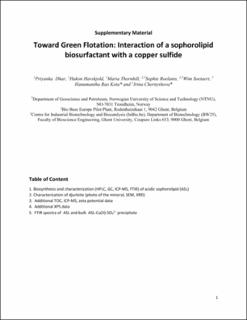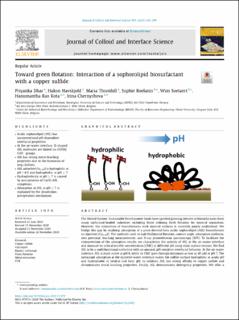| dc.contributor.author | Dhar, Priyanka | |
| dc.contributor.author | Havskjold, Håkon | |
| dc.contributor.author | Thornhill, Maria | |
| dc.contributor.author | Roelants, Sophie | |
| dc.contributor.author | Soetaert, Wim | |
| dc.contributor.author | Kota, Hanumantha Rao | |
| dc.contributor.author | Chernyshova, Irina | |
| dc.date.accessioned | 2021-02-04T08:41:07Z | |
| dc.date.available | 2021-02-04T08:41:07Z | |
| dc.date.created | 2020-11-23T12:54:58Z | |
| dc.date.issued | 2020 | |
| dc.identifier.issn | 0021-9797 | |
| dc.identifier.uri | https://hdl.handle.net/11250/2726090 | |
| dc.description.abstract | The United Nations’ Sustainable Development Goals have sparked growing interest in biosurfactants from many surfactant-loaded industries including those utilizing froth flotation for mineral separation. However, the interaction of biosurfactants with mineral surfaces is currently poorly understood. We bridge this gap by studying adsorption of a yeast-derived bola acidic sophorolipid (ASL) biosurfactant on djurleite (Cu1.94S). The methods used include Hallimond flotation, contact angle, adsorption isotherm, zeta potential, leaching measurements, and X-ray photoelectron spectroscopy (XPS). To facilitate the interpretation of the adsorption results, we characterize the activity of ASL at the air-water interface and measure its critical micelle concentration (CMC) at different pH using static surface tension. We find ASL to be a multifunctional surfactant with an unusual, pH-sensitive interfacial behavior. At the air-water interface, ASL is most active at pH 8, while its CMC goes through minimum as low as 40 μM at pH 7. The surfactant adsorption at the djurleite-water interface makes the sulfide surface hydrophilic at acidic pH and hydrophobic at neutral and basic pH. In addition, ASL has strong affinity to copper sulfide and demonstrates metal leaching properties. Finally, ASL demonstrates detergency properties. We offer a mechanistic interpretation of these findings. Our results provide a basis for the application of acidic glycolipids in froth flotation and have implications for their application in ion separation using hydrometallurgical routes, as well as for the chemical stability of metal sulfides in environmental systems. | en_US |
| dc.language.iso | eng | en_US |
| dc.publisher | Elsevier | en_US |
| dc.rights | Navngivelse 4.0 Internasjonal | * |
| dc.rights.uri | http://creativecommons.org/licenses/by/4.0/deed.no | * |
| dc.title | Toward Green Flotation: Interaction of a Sophorolipid Biosurfactant with a Copper Sulfide | en_US |
| dc.type | Peer reviewed | en_US |
| dc.type | Journal article | en_US |
| dc.description.version | publishedVersion | en_US |
| dc.source.journal | Journal of Colloid and Interface Science | en_US |
| dc.identifier.doi | 10.1016/j.jcis.2020.11.079 | |
| dc.identifier.cristin | 1851031 | |
| dc.description.localcode | © 2020 The Authors. Published by Elsevier Ltd. This is an open access article under the CC BY license (http://creativecommons.org/licenses/by/4.0/). | en_US |
| cristin.ispublished | true | |
| cristin.fulltext | original | |
| cristin.fulltext | original | |
| cristin.qualitycode | 1 | |


